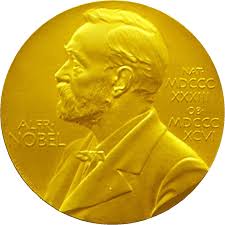A tiny lift,
artificial muscles and miniscule motors. The Royal Swedish
Academy of Sciences has decided to award the Nobel Prize inChemistry 2016 to Jean-Pierre Sauvage
of the University of Strasbourg in, France,
Sir Fraser Stoddart at the Northwestern
University in the USA, and Ben Feringa of the University of Groningen, the
Netherlands "for the design and synthesis of molecular machines”;
molecules with controllable movements, which can perform a task when energy is
added. The development of computing demonstrates how the miniaturisation of
technology can lead to a revolution.
The three 2016 Nobel Laureates in
Chemistry have miniaturised machines and taken sustainable chemistry to a new
dimension.
The first step towards a molecular machine was taken by
Jean-Pierre Sauvage in 1983, when he succeeded in linking two ring-shaped
molecules together to form a chain, called a catenane. Normally,
molecules are joined by strong covalent bonds in which the atoms share
electrons, but in the chain they were instead linked by a freer mechanical
bond. For a machine to be able to perform a task it must consist of parts
that can move relative to each other. The two interlocked rings fulfilled
exactly this requirement.
The second step was taken by Fraser Stoddart in 1991, when
he developed arotaxane. He threaded a molecular ring onto a thin
molecular axle and demonstrated that the ring was able to move along the axle.
Among his developments based on rotaxanes are a molecular lift, a molecular
muscle and a molecule-based computer chip.
Ben Feringa was the first person to develop a molecular
motor. In 1999 he got a molecular rotor blade to spin continually in the same
direction. Using molecular motors, he has rotated a glass cylinder that is 10 000
times bigger than the motor and also designed a nanocar (below).
The 2016 Nobel Laureates in Chemistry have taken molecular
systems out of equilibrium's stalemate and into energy-filled states in which
their movements can be controlled. In terms of development, the molecular motor
is at the same stage as the electric motor was in the 1830s, when scientists
displayed various spinning cranks and wheels, unaware that they would lead to
washing machines, fans and food processors.
Molecular machines are part of the sustainable chemistry tool
kit that will be used to develop future new materials, sensors and energy
storage systems. To learn more about their collective achievement a collection of their research papers, drawn from Nature Research journals, can be found here.
Feringa in Brussels
2016 Nobel laureate
Prof Ben Feringa will feature at the International Solvay
Institutes’ annual public event on Sunday 23 October 2016 at the Flagey Studios in Brussels. He
will be one of the main speakers on the theme of ‘‘Chemistry for the World of Tomorrow’’ and will highlight research at the frontiers of sustainable
chemistry.
The event will feature
three Nobel Chemistry laureates – two as its main speakers
- Green Chemistry for Sustainable Development by Professor Robert Grubbs (Caltech), 2005 Nobel Laureate in Chemistry, and
- The Art of Building Small by Professor Ben Feringa (Groningen) 2015 Laureate of the Solvay Prize and 2016 Nobel laureate
The lectures will be followed by a panel discussion of
distinguished scientists led by Professor Kurt Wüthrich (ETH and Scripps Institute), 2002
Nobel Laureate in Chemistry. The audience will also have the opportunity to ask
questions to the panel on the most pressing issues facing today’s chemistry.
The lectures and debate will be delivered in English with
simultaneous translations to Dutch and French. The event is free, but
participants must register in advance here.




No comments:
Post a Comment
Please post your comment here. Please note that this newsblog is not moderated.
Note: only a member of this blog may post a comment.